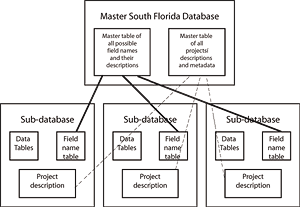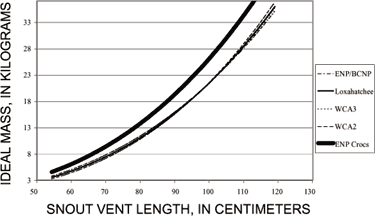U.S. Department of the Interior
U.S. Geological Survey
FS-140-02
Compilation of American Alligator Data Sets in South Florida for Restoration Needs
| Alligators have been identified as a key component of the Everglades ecosystem. Long-term changes in alligator numbers, nesting effort, growth, condition, and survival can be used as indicators of the health of the Everglades marsh system. Due to the sensitivity of alligators to hydrologic conditions, an alligator population model is being developed as part of the ATLSS program to evaluate ecosystem restoration alternatives. |
Historical data is used to make assessments of populations in relation to restoration and water management practices in the Everglades. Most life history characteristics are difficult to use to assess restoration progress, because decades of data are required. Condition, on the other hand,
can be calculated in a relatively simple manner. Condition can be defined as the "relative fatness of [an animal]....it is a measure of how well that animal is coping with its environment" (Taylor 1979). This definition is the key to using alligators as indicators of the health of their environment. Other parameters can be used to assess the health of a population (nesting effort, growth rate and survival, and density), but require much more data. Evaluating long-term trends and developing population models requires a large amount of data collected over a number of years at a number of locations. Information on alligator densities, nesting and growth have been collected in south Florida since the 1950s by rangers and researchers in Everglades National Park (ENP) and Big Cypress National Preserve (BCNP), Florida Fish and Wildlife Conservation Commission personnel, University researchers, and private consultants. Many of the most critical data sets (those having the largest amount of data or those from particular areas or years) are not accessible for use in evaluating restoration alternatives or developing models. The data are not available in a centralized, easily accessible, welldocumented database. Further, the size and scope of these data sets are not fully known. Thousands of individual records need to be evaluated, compiled, and entered into an appropriate database. It is critical that these data sets are accessible to establish restoration targets for alligator populations, develop models, and design short and long-term
monitoring tools for evaluating restoration success.
Evaluating long-term trends and developing population models requires a large amount of data collected over a number of years at a number of locations. Information on alligator densities, nesting and growth have been collected in south Florida since the 1950s by rangers and researchers in Everglades National Park (ENP) and Big Cypress National Preserve (BCNP), Florida Fish and Wildlife Conservation Commission personnel, University researchers, and private consultants. Many of the most critical data sets (those having the largest amount of data or those from particular areas or years) are not accessible for use in evaluating restoration alternatives or developing models. The data are not available in a centralized, easily accessible, welldocumented database. Further, the size and scope of these data sets are not fully known. Thousands of individual records need to be evaluated, compiled, and entered into an appropriate database. It is critical that these data sets are accessible to establish restoration targets for alligator populations, develop models, and design short and long-term
monitoring tools for evaluating restoration success.
Research Methods
Historical Data Sets - Managers and biologists in the field of alligator research were consulted to determine which data sets were critical, where they were, and the feasibility of obtaining them. Several databases have been collected and incorporated into an ACCESS database. Further, plans for including at least three additional databases are in preparation, including one that is in UNIVAC tape format. The tape will be sent to a data retrieval company to recover the alligator measurements. These numbers will have to be interpreted into actual data and entered into the database. Three databases have been obtained thus far: survey and nesting data from A.R.M. Loxahatchee National Wildlife Refuge, nesting data from the Florida Cooperative Fish and Wildlife Research Unit, and the United States Geological Survey(USGS)/Biological Resources Division(BRD) telemetry database which consists of over 50,000 entries.
 |
| Figure 1: South Florida Alligator database design [larger image] |
Each database consists of a data table, a metadata table, and a field name table. The data table contains only data available from the database. The metadata table provides a description of the project and pertinent collection information such as Global Positioning System (GPS) datum. The field name table includes all field names and their descriptions. One master database has been created and consists of two tables: a master metadata table and the master field name table, which compile all metadata and field name tables into one, easily searchable database.
Condition - The definition of a reasonable "condition factor" is necessary. Researchers often note that an alligator is "too skinny" or a "healthy size", but these observations are qualitative. Even when applied to individuals within one population these terms are not objectively informative. For crocodilians researchers tend to believe that fat is beneficial. Amongst crocodilians it is probably true that fatter females do produce larger clutches in a given year; however, there is no strong evidence that their lifetime productivity is higher. Furthermore, even when condition-assessments have been value-free, they have usually been qualitative rather than quantitative. So long as definitions of condition remain unquantified, there will be serious difficulties in attempting to compare condition across populations.
A graduate student has been employed to develop a body condition factor analysis. Condition factor can be calculated for any organism that has a length and weight associated with it. However, it is only an index and must be further explained with physiological data. For example, the use of condition factor indices in fisheries science has been supported in previous studies by destructive total body fat analysis. Therefore, the condition factor index is indicative of actual body fat content, a physiological measure. In this analysis, the primary goal will be to link alligator condition factor with a physiological factor. The graduate student's objectives are to:
- Determine which standard morphometric measures exhibit the least measurement error.
- Determine which condition factor index best discerns valid differences between populations.
- Determine which condition factor index correlates with a physiological factor or physiological state.
To define a preliminary condition factor and determine the health and condition of Everglades alligators, least-squares regression, (LSR) was used to create a length-weight curve for five separate areas of southern Florida (Loxahatchee National Wildlife Refuge, Water Conservation Area 2A, Water Conservation Area 3A North, Water Conservation Area 3A South, and ENP). The required constants for the following ideal mass equation were obtained for each area with LSR (SAS 1988):
Mass = a(SVL/100)b,where SVL is Snout Vent Length, and 'a' and 'b' are the constants for each area determined by LSR.
Ideal mass was calculated using a standard set of SVLs and the unique equation calculated for each area. The resultant curves for all populations (SVL relative to ideal mass) were plotted in one graph for comparison. For the Everglades alligators, there was little difference in condition from area to area. A 'length relative to ideal mass' curve was added for the American crocodile to broaden the comparison to all crocodilians in the Everglades. The crocodile condition curve was significantly higher than that of the Everglades alligators (fig. 2).
 |
| Figure 2: Condition comparison of Everglades alligators and Everglades crocodiles [larger image] |
References
Taylor, J.A. 1979. The foods and feeding habits of subadult Crocodylus porosus Schneider in Northern Australia: Australian Wildlife Research, V. 5, p. 385-399.
SAS Institute. 1988. SAS/STAT user's guide. Release 6.03 edition. SAS Institute, Cary, North Carolina, USA.
 |
 |
The Critical Ecosystem Studies Initiative supports studies conducted to provide physical and biological information, simulation modeling, and planning that are critical for achieving South Florida ecosystem restoration
For more information contact:
Dr. Kenneth G. Rice
U.S. Geological Survey-BRD
Florida Caribbean Science Center
Restoration Ecology Branch
University of Florida Field Station
3205 College Avenue
Fort Lauderdale, FL 33314
ken_g_rice@usgs.govCo-investigators:
Frank J. Mazzotti, University of Florida
Clarence L. Abercrombie, Wofford College
Christa L. Zweig, University of Florida
Laura A. Brandt, US Fish and Wildlife Service
Related information:
Related Project: Compilation of Alligator Data Sets in South Florida for Restoration Needs
This page is: http://sofia.usgs.gov /publications/fs/140-02/index.html
Comments and suggestions? Contact: Heather Henkel - Webmaster
Last updated: 02 April, 2003 @ 08:48 AM (KP)
